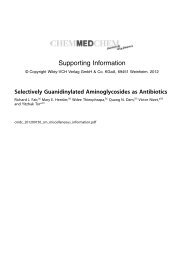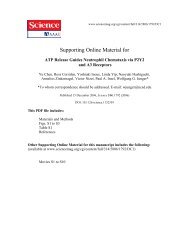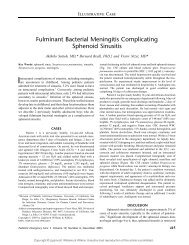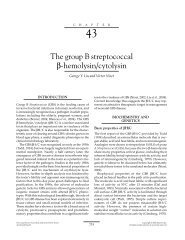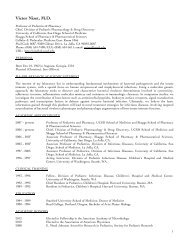BACTERIAL SEPSIS AND MENINGITIS - Nizet Laboratory at UCSD
BACTERIAL SEPSIS AND MENINGITIS - Nizet Laboratory at UCSD
BACTERIAL SEPSIS AND MENINGITIS - Nizet Laboratory at UCSD
Create successful ePaper yourself
Turn your PDF publications into a flip-book with our unique Google optimized e-Paper software.
IVIG on subsequent outcomes. The results revealed a<br />
borderline significant reduction in mortality (rel<strong>at</strong>ive risk<br />
0.63, 95% confidence interval 0.40 to 1.00). In the studies<br />
in which analysis was restricted to neon<strong>at</strong>es with subsequently<br />
proven systemic bacterial infection, a st<strong>at</strong>istically<br />
significant reduction of mortality was identified (rel<strong>at</strong>ive<br />
risk 0.55, 95% confidence interval 0.31 to 0.98). Based<br />
on these preliminary encouraging d<strong>at</strong>a from diverse studies,<br />
an ongoing, placebo-controlled multicenter trial in<br />
low birth weight or ventil<strong>at</strong>ed neon<strong>at</strong>es (INIS [Intern<strong>at</strong>ional<br />
Neon<strong>at</strong>al Immunotherapy Study]) is comparing<br />
the adjunctive use of 10 mg/kg of IVIG versus placebo<br />
<strong>at</strong> the time of suspected infection and 48 hours l<strong>at</strong>er; mortality<br />
and major disability <strong>at</strong> 2 years are the major outcome<br />
variables [662].<br />
PROGNOSIS<br />
Before the advent of antibiotics, almost all infants with<br />
neon<strong>at</strong>al sepsis died [5]. Dunham [2] reported th<strong>at</strong> physicians<br />
used various tre<strong>at</strong>ments, including “erysipelas<br />
serum” and transfusions, without altering the course of<br />
the disease. The introduction of sulfonamides and penicillin<br />
and l<strong>at</strong>er introduction of broad-spectrum antibiotics<br />
such as chloramphenicol and streptomycin decreased the<br />
mortality r<strong>at</strong>e to about 60% [3,5]. During this period,<br />
some infants undoubtedly died because of tre<strong>at</strong>ment with<br />
high dosages of chloramphenicol, which can cause cardiovascular<br />
collapse (i.e., gray baby syndrome).<br />
The introduction of the aminoglycosides, first with<br />
kanamycin in the early 1960s and gentamicin l<strong>at</strong>e in th<strong>at</strong><br />
decade, vastly improved therapy for bacteremia caused by<br />
gram-neg<strong>at</strong>ive organisms, the leading cause of sepsis <strong>at</strong> th<strong>at</strong><br />
time [6]. These therapies, together with an improved<br />
understanding of neon<strong>at</strong>al physiology and advances in<br />
life-support systems, combined to result in a steady<br />
decrease in neon<strong>at</strong>al mortality in the United St<strong>at</strong>es [6] and<br />
in Europe [257,258,286,663] during the period 1960-<br />
1985. Mortality r<strong>at</strong>es for sepsis, including infants of all<br />
weights and gest<strong>at</strong>ional ages, decreased from 40% to 50%<br />
in the 1960s [4,6,286,663] to 10% to 20% in the 1970s<br />
and 1980s [6,10,258,447,663]. Popul<strong>at</strong>ion-based surveillance<br />
of selected counties in the United St<strong>at</strong>es conducted<br />
by the CDC from 1993-1998 reported 2196 cases of neon<strong>at</strong>al<br />
sepsis caused by GBS, of which 92 (4%) were f<strong>at</strong>al [643].<br />
The postn<strong>at</strong>al age <strong>at</strong> which infection occurs, previously<br />
thought to be of prognostic significance, has become less<br />
important within the past 2 decades. Fulminant sepsis,<br />
with signs of illness present <strong>at</strong> birth or during the first<br />
day of life, has a high mortality r<strong>at</strong>e, ranging from 14%<br />
to 20% [6,12,258,288] to 70% [664]. When infections<br />
occurring during the first 24 hours of life, most of which<br />
are caused by GBS, are excluded from the analysis, however,<br />
the percentage of de<strong>at</strong>hs resulting from early-onset<br />
sepsis does not differ significantly from l<strong>at</strong>e-onset infection.*<br />
Mortality from sepsis is higher for preterm than<br />
for term infants in virtually all published studies, { but is<br />
*References [6, 10, 85, 257, 258, 286, 447].<br />
{ References [7, 10, 12, 18, 257, 258, 446, 447].<br />
CHAPTER 6 Bacterial Sepsis and Meningitis<br />
263<br />
approxim<strong>at</strong>ely the same for all major bacterial p<strong>at</strong>hogens<br />
(see Tables 6–4 and 6–5) [10,257].<br />
In more recent surveys, the mortality r<strong>at</strong>e for neon<strong>at</strong>al<br />
meningitis has declined from 25% [10,24,665,666] to<br />
10% to 15% [12,23,26,667,668]. This decrease represents<br />
a significant improvement from prior years, when<br />
studies reported a case-f<strong>at</strong>ality r<strong>at</strong>e of more than 30%<br />
[21,431,648,649,669]. Mortality is gre<strong>at</strong>er among preterm<br />
than term infants [12,23,26,670].<br />
Significant sequelae develop in 17% to 60% of infants<br />
who survive neon<strong>at</strong>al meningitis caused by gram-neg<strong>at</strong>ive<br />
enteric bacilli or GBS [23,665–668]. These sequelae<br />
include mental and motor disabilities, convulsive disorders,<br />
hydrocephalus, hearing loss, and abnormal speech<br />
p<strong>at</strong>terns. The most extensive experience with the longterm<br />
observ<strong>at</strong>ion of infants who had group B streptococcal<br />
meningitis as neon<strong>at</strong>es was reported by Edwards<br />
and colleagues [670]. During the period 1974-1979,<br />
61 p<strong>at</strong>ients were tre<strong>at</strong>ed, and 21% died. Of the 38 survivors<br />
who were available for evalu<strong>at</strong>ion <strong>at</strong> 3 years of age<br />
or older, 29% had severe neurologic sequelae, 21% had<br />
minor deficits, and 50% were functioning normally. Presenting<br />
factors th<strong>at</strong> were associ<strong>at</strong>ed with de<strong>at</strong>h or severe<br />
disability included com<strong>at</strong>ose or semicom<strong>at</strong>ose st<strong>at</strong>e,<br />
decreased perfusion, total peripheral white blood cell<br />
count less than 5000/mm 3 , absolute neutrophil count less<br />
than 1000/mm 3 , and CSF protein level gre<strong>at</strong>er than<br />
300 mg/dL.<br />
A comparable study evalu<strong>at</strong>ing 35 newborns over 3 to<br />
18 years showed more favorable outcomes with 60% of<br />
survivors considered normal <strong>at</strong> the time of follow-up<br />
compared with sibling controls, 15% with mild to moder<strong>at</strong>e<br />
neurologic residua, and 25% with major sequelae<br />
[669]. Franco and coworkers [668] reported the results<br />
of frequent and extensive neurologic, developmental,<br />
and psychometric assessments on a cohort of 10 survivors<br />
of group B streptococcal meningitis followed for 1 to 14<br />
years. The investig<strong>at</strong>ors found th<strong>at</strong> one child had severe<br />
CNS damage; five children, including one with hydrocephalus,<br />
had mild academic or behavioral problems;<br />
and four children were normal.<br />
The neurodevelopmental outcomes described for<br />
infants with gram-neg<strong>at</strong>ive bacillary meningitis are similar<br />
to the outcomes reported for group B streptococcal meningitis.<br />
Unhanand and colleagues [23] reported findings<br />
from their 21-year experience with gram-neg<strong>at</strong>ive meningitis<br />
<strong>at</strong> two hospitals in Dallas, Texas. Of 72 p<strong>at</strong>ients less<br />
than 28 days old <strong>at</strong> the onset of symptoms, there were 60<br />
survivors, 43 of whom were followed and evalu<strong>at</strong>ed for <strong>at</strong><br />
least 6 months. Neurologic sequelae, occurring alone or<br />
in combin<strong>at</strong>ion, were described in 56% and included<br />
hydrocephalus (approxim<strong>at</strong>ely 30%), seizure disorder<br />
(approxim<strong>at</strong>ely 30%), developmental delay (approxim<strong>at</strong>ely<br />
30%), cerebral palsy (25%), and hearing loss<br />
(15%). At follow-up, 44% of the survivors were developmentally<br />
normal <strong>at</strong> follow-up. Among infants with gramneg<strong>at</strong>ive<br />
bacillary meningitis, thrombocytopenia, CSF<br />
white blood cell count gre<strong>at</strong>er than 2000/mm 3 , CSF protein<br />
gre<strong>at</strong>er than 200 mg/dL, CSF glucose-to-blood glucose<br />
r<strong>at</strong>io of less than 0.5, prolonged (>48 hours) positive<br />
CSF cultures, and elev<strong>at</strong>ed endotoxin and interleukin-1<br />
concentr<strong>at</strong>ions in CSF were indic<strong>at</strong>ors of a poor outcome



